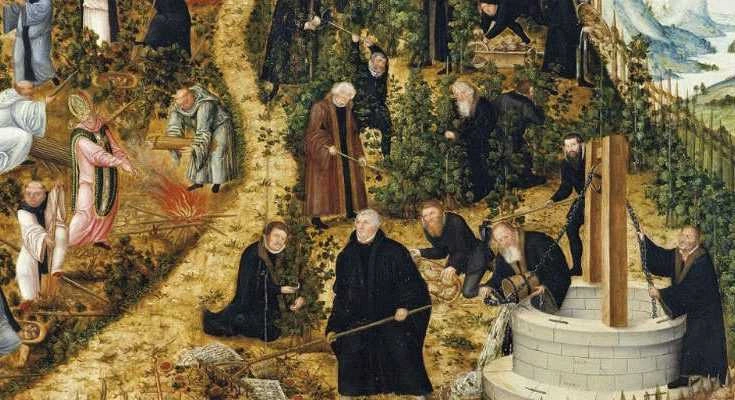In our History of British Gardening Series – Sadly, no existing medieval gardens have survived in their entirety in Europe, and historical documentation on gardens and plants is scarce. Much of what we know is from paintings.
| History of British Gardening Series |
|---|
| Roman |
| Medieval |
| Tudor and Stewart |
| Restoration |
| Georgian and Regency |
| Victorian |
| Edwardian |
| Modern |
Timeline
c.1087 The Doomsday Book is written – showing ownership of land and property for the first time.
c.1178 A stained glass window features one of the earliest images of a garden tool. The image at Canterbury Cathedral shows Adam delving with a spade and a mattock. A spade with an iron tip and a wood base became common in the 12th century. It’s one of the oldest panels in the cathedral.
c.1190 De Naturis Rerum by Alexander Neckham is published, which lists 200 plants. Some of these plants may not have been growing in Britain – but were encountered during the Crusades. Neckham was a prolific writer and is thought to have made the earliest known reference to a wheelbarrow.
c.1237 Roman de la Rose is started. It’s the most famous literary celebration of gardens in this era. It was later translated into English by Chaucer.
c.1340 According to some sources, rosemary was introduced by Philippa of Hainault, the wife of Edward III. Philippa received cuttings from her mother in Antwerp.
c.1440 John the Gardener wrote a verse treatise on gardening called The Feate of Gardening. The verse is considered to be the first practical manual about English gardening.
Medieval Style of Gardening
The earliest paper record of ornamental gardens is a plan of Canterbury Cathedral in about 1160, in the Middle Ages, showing a herbarium in an infirmary cloister.
Christianity had an important role to play and most large gardens were part of monasteries. The monastery cloister would provide open, green space surrounded by covered walks, usually with a well or fountain at the center. Monks would use them for walking, reading, and as places of quiet contemplation.
The monks frequently medicinal herbs, vegetables, and flowers within an “enclosed garden” known as a hortus conclusus, typically situated in the monastery’s courtyard or cloister. Fruit trees were commonly grown outside of the garden in orchards. Other trees were grown as part of forests or woodland.

Many of the flowers used in monasteries had a religious symbolism. For example, violas represented the humility of the Virgin Mary, while carnations, which were introduced from Spain the in 1470s, represented the incarnation. White roses were associated with the Virgin Mary; red ones were linked with the blood of Christ or the Christian martyrs.
In the rose garden, several native roses were available in medieval times, including Rosa gallica var. officinalis (the Apothecary’s rose) and Rosa alba (the white rose of York). Many of these flowers would be grown to decorate the altar. Features in a medieval garden included flowery meads, turf seats, and seated arbors.
The Rosamund bower became a significant feature in monastic gardens after the legend of Rosamund Clifford, the mistress of Henry II. A bower was created on the grounds to keep her hidden from the King’s jealous wife. Sadly, the bower proved no help to fair Rosamund and she was murdered by Queen Eleanor.
Medieval gardens served a multifaceted role, serving not only as sites for cultivating fruits, vegetables (kitchen gardens), and medicinal plants but also as spaces for leisure and contemplation. Inside the protective embrace of castle walls, medieval castle gardens featured lawns, arbors, and flower borders. Beyond the castle fortifications, expansive grounds were artfully designed for entertainment and hunting, frequently featuring grand structures to host these festivities.
Castles occasionally incorporated petite courtyard gardens, complete with pathways winding through elevated flower beds.
Pleasure gardens in medieval times in the Great Brittain, often referred to as “pleasaunces” or “pleasure grounds,” were spaces designed for relaxation, leisure, and enjoyment. They were typically found within or near castles, monasteries, and the estates of nobility. They were not only places of beauty but also symbols of status and luxury through the medieval period.
Medieval characters
Friar Henry Daniel
An outstanding field naturalist, botanist, and skilled gardener, Friar Henry Daniel spent seven years training as a physician before becoming a Dominican Friar.
He grew 252 plants in his gardens at Stepney and wrote many treatises on gardening and in particular herbs native to Britain, including detailed descriptions of soil and climates.
The original content was published on the BBC Gardening website, however, the Design section with all of its content has been removed. We try to keep this great content alive here on the Gardenlife Pro site.

